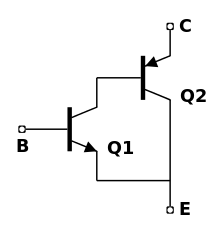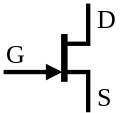Sziklai pair

In electronics, the Sziklai pair (also known as a "complementary feedback pair" (CFP) or "compound transistor") is a configuration of two bipolar transistors, similar to a Darlington pair.[1] In contrast to the Darlington arrangement, the Sziklai pair has one NPN and one PNP transistor, and so it is sometimes also called the "complementary Darlington". Current gain is similar to that of a Darlington pair, which is the product of the gains of the two transistors. The configuration is named for its early popularizer, George C. Sziklai.
In a typical application the Sziklai pair acts somewhat like a single transistor with the same type (e.g. NPN) as Q1 and with a very high current gain (β). The emitter of Q2 acts the role of a collector. Hence the emitter of Q2 is labeled "C" in the figure to the right. Likewise, in a typical application the collector of Q2 (also connected to the emitter of Q1) plays the role of an emitter and is thus labeled "E."
The figure at the right illustrates a NPN-PNP pair that acts like a single NPN transistor overall. By replacing Q1 with a PNP transistor and Q2 with a NPN transistor the pair will act like a PNP transistor overall. (Just reverse the two arrows in the figure to visualize the PNP-NPN pair.)
One advantage over the Darlington pair is that the base turn-on voltage is only about 0.6V or half of the Darlington's 1.2V nominal turn-on voltage. Like the Darlington, it can saturate only to 0.6V, which is a drawback for high-power stages.
As with a Darlington pair, a resistor (e.g., 100Ω–1kΩ) is usually connected between Q2's emitter and base to improve its turn-off time (i.e., its performance for high frequency signals).[1] Note that Q2's emitter is labeled "C" in the figure to the upper right.
Sziklai-based output stages
Sziklai pairs are sometimes used in the push–pull output stage of power amplifiers (e.g., for audio) when the designer wants to use devices of the same type (e.g., NPN), instead of complementary types, which rarely match accurately. That is, rather than using a Darlington NPN push pair (i.e., two NPN transistors) and a Darlington PNP pull pair (i.e., two PNP transistors), the designer uses Sziklai pairs for both the upper push pair and the lower pull pair. By using two Darlington pairs, the designer is hoping that the combination of two NPN transistors will have similar characteristics of two PNP transistors. By using two Sziklai pairs which both have mixed NPN/PNP type, the intent is to improve push–pull matching.
Sziklai pairs can also have the benefit of superior thermal stability under the right conditions. In contrast to the traditional Darlington configuration, quiescent current is much more stable with respect to changes in the temperature of the higher power output transistors vs the lower power drivers.[2] This means that a Sziklai output stage in a class AB amplifier requires only that the bias servo transistor or diodes be thermally matched to the lower power driver transistors; they need not (and should not) be placed on the main heatsink. This potentially simplifies the design and implementation of a stable class AB amplifier, reducing the need for emitter resistors,[3] significantly reducing the number of components which must be in thermal contact with the heatsink and reducing the likelihood to thermal runaway.
Designers also sometimes use a "quasi-complementary" configuration, which uses a Darlington push pair (i.e., two NPN transistors) and a Sziklai pull pair (i.e., one PNP and one NPN transistor). This configuration, which uses three NPN transistors and one PNP transistor, is advantageous because:
- Silicon PNP transistors have historically been more expensive than their NPN counterparts (one factor is lower volume production and usage of PNP power transistors).
- The performance of the lower pull pair, which uses a single NPN transistor, more closely matches the performance of the upper push pair, which consists of two NPN transistors (PNP transistors have lower carrier mobility).
Recently, PNP and NPN transistors have become roughly equally available and have more closely matched performance characteristics, and so modern audio power amplifiers often use equivalent topologies for both pairs (e.g., both Sziklai pairs as described above). Some claim that using two Sziklai pairs gives a better sound than Darlington-based designs due to their greater inherent linearity.[4]
See also
References
- ↑ 1.0 1.1 Horowitz, Paul; Winfield Hill (1989). The Art of Electronics. Cambridge University Press. ISBN 0-521-37095-7.
- ↑ http://sound.westhost.com/articles/cmpd-vs-darl.htm
- ↑ http://sound.westhost.com/project03.htm
- ↑ AmpsLab: Complementary Feedback Power Amp Output
External links
- U.S. Patent 2,762,870 Push-pull complementary type transistor amplifier. G.C.Sziklai, September 11, 1956
- U.S. Patent 2,791,644 Push-pull amplifier with complementary type transistors. G.C.Sziklai, May 7, 1957
- ECE 327: Procedures for Output Filtering Lab — Section 4 ("Power Amplifier") discusses design of a BJT-Sziklai-pair-based class-AB current driver in detail.
| ||||||||||||||||||

.svg.png)